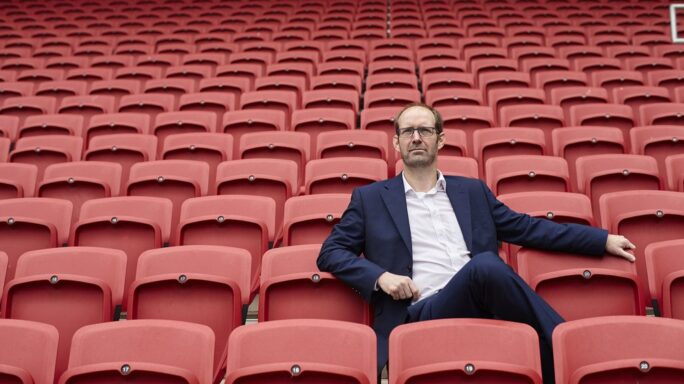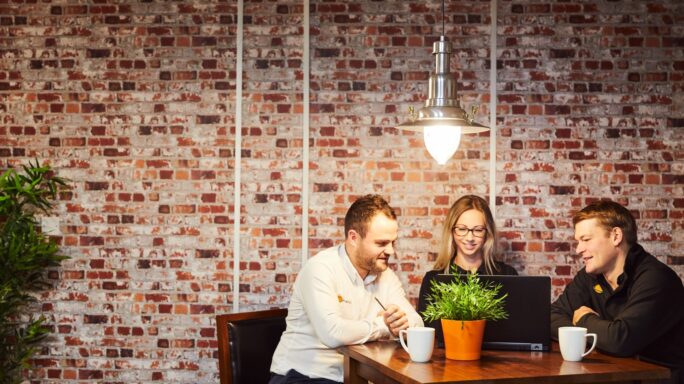Technology & Innovation
5 tips from De Beers for CFOs on taking measured risks
The chief financial officer of De Beers shares advice on taking measured risks and offers five pieces of advice for CFOs who are seeking to make an impact.

Established businesses with a rich history of success must have a strategy when it comes to innovation, just like every other company. That also means taking measured risks is important to survive.
Customer expectations in all industries continue to evolve, meaning businesses can’t rest on their laurels, even if they are successful and large enough to have a significant share of their market.
Taking risks to keep moving forward is important. And with that, finance and digital transformation have big parts to play in future survival and success.
De Beers Group is a world-famous business that has been mining, selling and manufacturing diamonds for 130 years. Until the start of the 21st century, De Beers controlled the entire diamond market but competition means that has become much more fragmented and competitive.
Consumer preferences have also changed. Millennials, for example, shop differently and have different tastes than their parents or grandparents. They also have an “always on” communications attitude – one that demands an omnichannel retail experience.
Nimesh Patel is the chief financial officer (CFO) of De Beers Group. A former investment banker by trade, he shared his thoughts on innovation and digital transformation with an audience of financial leaders and CFOs at the 2018 CFO Rising conference in London.
“De Beers is a 130-year-old business and we’ve been the leader in our market since day one,” said Nimesh. “But we recognise all around us the pace of change, whether that’s new technology, changing consumer preferences, innovative retail models, and with us – laboratory grown diamonds with consumers.”
In this article, Nimesh admits that De Beers understands the importance of taking measured risks to ensure it appeals to both new and existing customers. He also shares advice on five areas that CFOs and their businesses should consider when it comes to taking risks and moving their companies in the right direction.
1. Don’t wait to make business changes
De Beers hit the headlines earlier in 2018 with the creation of a new brand, Lightbox Jewelry, its entry into the lab-grown diamond market. To many observers, this was surprising since the synthetic category accounts for only 2% of the entire global supply (although analysts believe there is potential for this to increase rapidly).
Retailers have previously been dismissive about lab-grown diamonds but De Beers has made a bet that cheaper synthetic substitutes will make a splash with consumers, who it believe will buy them as affordable complementary fashion products, rather than diamonds that can cost small fortunes.
For De Beers, this is about realising changes need to be made now rather than waiting until it’s too late to make a move.
These new lab-grown diamonds come in at around $400 (£312) a carat, which is around 90% cheaper than natural diamonds and 25% cheaper than current lab-grown diamonds.
Nimesh said: “We’re responding to what consumers have told us. They’ve told us they want fun, fashionable jewellery and that’s what we’ve given them, with lots of pinks and blues in that mix.
“This product doesn’t have the enduring value of natural stone – it’s not rare and it’s not finite. A one carat stone takes three to four weeks to grow in a machine. These products are not for forever but they’re perfect for right now.
“We’ve described this strategy as disrupting the disruptors. You can imagine how brave a move it felt when we launched Lightbox, and still feels today, and how much risk remains in that approach for a business that generates $6 billion from selling natural diamonds.”
De Beers is investing money into digitising each diamond plant by a creating digital twin, supported by predictive analytics and allowing the business to undertake preventative maintenance. That means proactively highlighting where and when to shut down, rather than doing it on a rolling and regular basis which is less efficient.
Nimesh added: “Beyond that, through the data we’ve created, we’ve also realised we can make the necessary changes to optimise performance.”
2. Consider new technologies such as blockchain
Another technology that has attracted the attention of manufacturers is blockchain, which has potential benefits for supply chains.
Usually, company information passes through a supply chain with no agreement on data taxonomy. Blockchain has the capability to create more effective supply chains by tracking the journey of products through smarter and secure audit trails that have real-time visibility.
With this in mind, De Beers has invested money and resources in blockchain through a platform called Tracr. This will be the first platform to digitally track a diamond’s journey from beginning to end – from where it’s mined to when a customer gets their hands on it.
Nimesh said: “It will provide a single immutable record for every diamond registered in the platform. This will underpin consumer confidence in a way that’s not previously been possible, while also enhancing efficiency.
“We’re already involved other leading diamond manufacturers and our customers in the pilot, tracking hundreds of high-value stones from mine to retail. We’re looking at other strategic partners – ultimately the idea is not that this is a De Beers platform but an industry platform.”
Tracr works by tracing valuable stones across the value chain through a unique ID, with scanning technology collecting more than 200 data points behind each product, giving consumers confidence that the product is real and what the business says it is.
The system also integrates with the record-keeping systems of participants, with data consolidated into immutable digital trails for each physical diamond.
What’s the value proposition for businesses looking to invest time and money in blockchain? For producers, it can help underpin confidence in the product they produce, sustaining a level of consumer demand that their industry might see today.
With Tracr, diamond manufacturers also get increased visibility, facilitating access to financing from institutions such as banks, as there is trust in every stone that exists in the blockchain. Retailers can also get different consumer-tailored products, with the ability to tell the story of a stone before purchase.
Sage Business Cloud X3
Need better insights into your business? Sage Business Cloud X3 provides you with fast, simple and flexible business management, helping you to manage your business and boost your profits.

3. Think about how finance can drive innovation
“As CFO of the De Beers group, I’ve had to think about how we manage the core of our business and continue to deliver returns to our shareholders, while at the same time disrupting our own business through initiatives such as the launching of a lab-grown diamond business so that we have a sustainable future,” said Nimesh.
“Technology has the ability to enhance our operating models and how we conduct our business, and that allows us to deliver meaningful cost savings. But it also has the potential to disrupt entirely what we do. This forces us to question our purpose, why we exist and what do we do.
“What’s pushing us to change is not necessarily how we do things, but in asking the fundamental question – what is it that we do?”
Nimesh went to Silicon Valley where he met with a business that was looking to automate its processes, so it could cut costs. This company had developed machines to replace humans in the role of taking items off shelves. What it found was machines didn’t have the dexterity to take different objects off shelves of different heights.
What this business did do was find that machines were good at optimising routes around a warehouse, as well as working out which objects could be picked and in which order to do so – this dramatically reduced the time taken to fulfil orders.
The machines were figuring out what to pick up, where and when, ordering humans to pick items off the shelves.
As automated intelligent analysis and pre-emptive decision-making takes hold, people need to think about their own roles. Nimesh believes it centres around creativity and having a vision – things machines can’t do as well (not at the moment, anyway).
He said: “I distinguish between two concepts – the concept of management which is the delivery of a plan, and the concept of leadership, which is having ambition, without a concrete plan. That is how I think about the purpose of finance in the role of driving innovation.
“Leadership is provided by people who deliver the vision. Finance is accountable with the CEO, management team or the board, to develop a strategy and navigate towards that required end state as defined by the strategy.
“CFOs focus on long-term business planning and resource allocation – resource in people as much as capital. We maintain resilience for that planning by thinking about different scenarios. We have to make sure we’re prepared for all of those outcomes, while having a robust balance sheet.
“Our role is in guiding organisations through their transformational journeys, which is critical to success. We also have the ability to dictate the pace of change, measuring success or otherwise along that path.”
4. Bring in fresh thinking and expertise
Nimesh believes that in the past, CFOs were tasked to bring balance in internal debates around growth in investment – the voice in the room who focuses on returns and the robustness of the balance sheet. He said that today, CFOs must be prepared to drive innovation and growth by adopting the appropriate allocation model to provide a framework to manage spending.
He added: “It’s about bringing in fresh, diverse thinking and expertise. It’s also about creating the right structures to get unfettered thinking, while staying focused on our business objectives.
“That lends itself to the creation of a small integrated team with a mix of skills – people external and internal to the organisation. People who understand markets and products, alongside people who understand the technology.
“At De Beers, we took top talent away from their day jobs and relocated them off campus to work on specific projects – the Lightbox and Tracr initiatives were born in that way.”
5. Change the way you use data
Data is also important. Finance has long been adept at collecting and analysing data, but what it needs to do is expand its definition of data and the reach of a business in putting it together.
It’s not just financial information and operational metrics – it’s a broader suite of data that is often qualitative as well as quantitative – the complication of indices based on customer feedback and market sentiment trackers, for example.
Nimesh said of De Beers: “It’s also about partnership. Our limited resources are stretched incredibly thinly. We need to rely on external expertise and sometimes external capital to help us succeed and manage multiple projects.
“We need to understand the value we bring. CFOs can understand the commercial applications of pre-existing technology. We can take the technologies and turn them into commercial applications with business models which drive revenue and profit.
“Others will bring the skill to develop that technology and adapt it. It’s about getting the synthesis right between two partners [technology and finance].”
MTD: Drive digital transformation through financial compliance
Medium and large businesses need to be aware of Making Tax Digital. Read this guide to learn why and discover what it means in relation to digital transformation.







Ask the author a question or share your advice